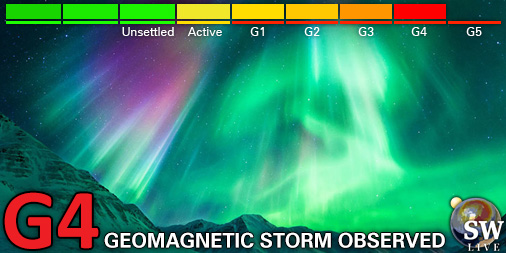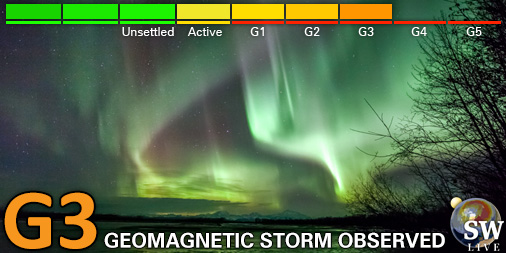Viewing archive of Wednesday, 27 November 2002
Solar activity report
Any mentioned solar flare in this report has a scaling factor applied by the Space Weather Prediction Center (SWPC). Because of the SWPC scaling factor, solar flares are reported as 42% smaller than for the science quality data. The scaling factor has been removed from our archived solar flare data to reflect the true physical units.
Report of Solar-Geophysical Activity 2002 Nov 27 2200 UTCPrepared by the NOAA © SWPC and processed by SpaceWeatherLive.com
Joint USAF/NOAA Report of Solar and Geophysical Activity
SDF Number 331 Issued at 2200Z on 27 Nov 2002IA. Analysis of Solar Active Regions and Activity from 26-2100Z to 27-2100Z
Solar activity was low. The largest event of the
period was a C6/Sf from Region 198 (S18W75) at 27/0119 UTC. Four
new regions were numbered today. Of these, new Region 207 (S19E69)
is the largest and most complex, and produced five subfaint C-class
flares today. The smaller and somewhat less complex new Region 204
(N16E40) produced two similar events during the period. The other
new and existing regions on the visible disk are all small and
simply structured spot groups, and produced no observed flares
today.
IB. Solar Activity Forecast
Solar activity is expected to be low
to moderate. Region 198 remains a potential source of M-class
activity until it transits the west limb on day two of the forecast
period. Region 207 appears to present an additional possible source
of moderate flare activity for the period.
IIA. Geophysical Activity Summary 26-2100Z to 27-2100Z
The geomagnetic field ranged from quiet to minor storm levels. An
interplanetary shock passage was observed on the ACE spacecraft at
26/2110 UTC, in likely association with the CME activity that
occurred on 24 November. A geomagnetic sudden impulse was observed
at 26/2150 UTC (18 nT on the Boulder magnetometer) and was followed
by an isolated period of minor storming at mid and high latitudes.
Predominantly active conditions followed and persisted for most of
the remaining summary period, dropping to mainly unsettled levels
near the end. The greater than 2 MeV electron flux at
geosynchronous orbit saw a tenfold decrease from the high values
observed yesterday.
IIB. Geophysical Activity Forecast
The geomagnetic field is
expected to be mainly quiet to unsettled. Isolated active periods
are possible for the next 24-48 hours as the current geomagnetic
storm activity continues to wane.
III. Event Probabilities 28 Nov to 30 Nov
| Class M | 40% | 40% | 40% |
| Class X | 05% | 05% | 05% |
| Proton | 05% | 05% | 01% |
| PCAF | green | ||
IV. Penticton 10.7 cm Flux
Observed 27 Nov 143 Predicted 28 Nov-30 Nov 150/155/160 90 Day Mean 27 Nov 171
V. Geomagnetic A Indices
Observed Afr/Ap 26 Nov 006/014 Estimated Afr/Ap 27 Nov 015/024 Predicted Afr/Ap 28 Nov-30 Nov 012/015-012/015-010/012
VI. Geomagnetic Activity Probabilities 28 Nov to 30 Nov
| A. Middle Latitudes | |||
|---|---|---|---|
| Active | 25% | 25% | 20% |
| Minor storm | 05% | 05% | 05% |
| Major-severe storm | 01% | 01% | 01% |
| B. High Latitudes | |||
|---|---|---|---|
| Active | 30% | 30% | 25% |
| Minor storm | 10% | 10% | 05% |
| Major-severe storm | 01% | 01% | 01% |
All times in UTC
Latest news
Latest forum messages
2025/04/12-13 Filament CMEs 2025/04/16 G3 Watch 480Filaments and prominences 68Coronal holes 51AR4064 9Incoming & Unnumbered Active Regions 1742
More topicsSupport SpaceWeatherLive.com!
A lot of people come to SpaceWeatherLive to follow the Sun's activity or if there is aurora to be seen, but with more traffic comes higher server costs. Consider a donation if you enjoy SpaceWeatherLive so we can keep the website online!

Latest alerts
Wednesday, 16 April 2025
21:45 UTC - Geomagnetic activity
Minor G1 geomagnetic storm (Kp5) Threshold Reached: 21:36 UTC
21:00 UTC - Geomagnetic activity
Severe G4 geomagnetic storm (Kp8) Threshold Reached: 20:55 UTC
19:45 UTC - Geomagnetic activity
Strong G3 geomagnetic storm (Kp7) Threshold Reached: 19:25 UTC
19:00 UTC - Geomagnetic activity
Moderate G2 geomagnetic storm (Kp6) Threshold Reached: 18:38 UTC
18:45 UTC - Geomagnetic activity
Minor G1 geomagnetic storm (Kp5) Threshold Reached: 18:28 UTC
Space weather facts
| Last X-flare | 2025/03/28 | X1.1 |
| Last M-flare | 2025/04/15 | M1.2 |
| Last geomagnetic storm | 2025/04/16 | Kp8- (G4) |
| Spotless days | |
|---|---|
| Last spotless day | 2022/06/08 |
| Monthly mean Sunspot Number | |
|---|---|
| March 2025 | 134.2 -20.4 |
| April 2025 | 120.7 -13.5 |
| Last 30 days | 120.8 -19.6 |







